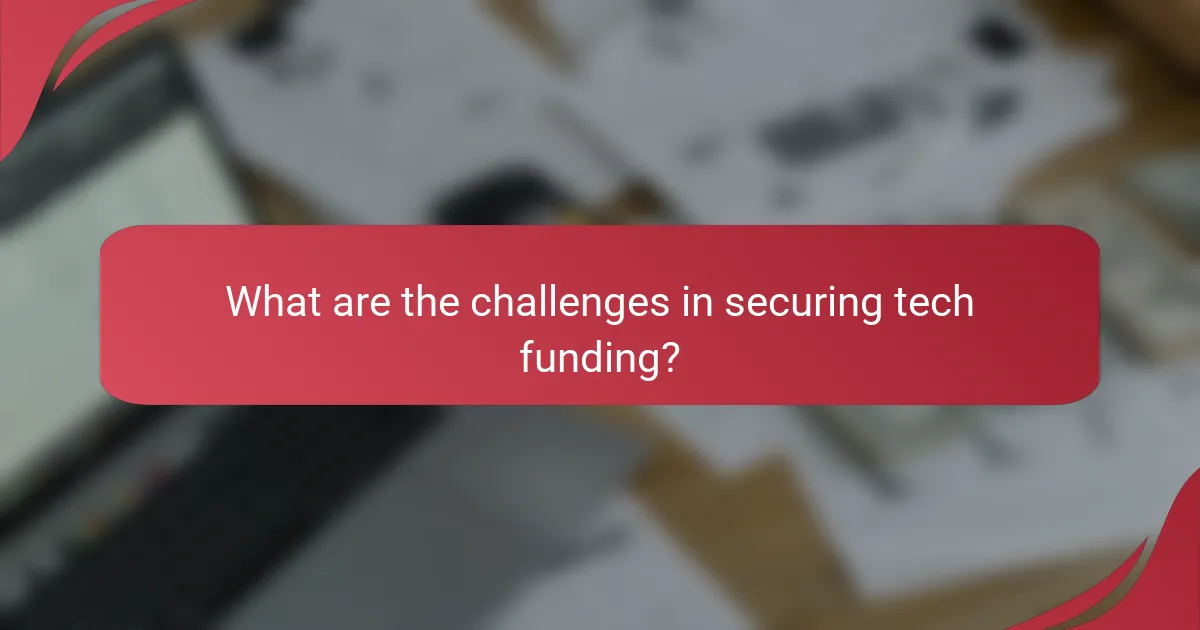The tech industry is navigating a dynamic landscape of funding trends, characterized by increased venture capital and angel investments, a growing emphasis on sustainability, and the rise of crowdfunding platforms. Startups aiming to secure funding in 2024 should focus on crafting robust business plans, fostering relationships with investors, and utilizing online funding avenues. Understanding the key factors that influence funding decisions, such as market demand and team expertise, is essential for attracting investment and ensuring growth.

What are the current funding trends in the tech industry?
The tech industry is experiencing several significant funding trends, including increased venture capital investments, a rise in angel investments, a focus on sustainability, the emergence of crowdfunding platforms, and the identification of geographic hotspots for funding. These trends reflect evolving investor priorities and market dynamics.
Venture capital growth
Venture capital (VC) funding has seen substantial growth, with many firms increasing their capital allocations to tech startups. This trend is driven by the potential for high returns in innovative sectors such as artificial intelligence, fintech, and health tech. Startups are encouraged to seek VC funding to scale quickly and gain market traction.
Investors are looking for companies with strong business models and scalable solutions. Founders should prepare detailed pitches that highlight their unique value propositions and market potential to attract VC interest.
Increased angel investments
Angel investments have surged as more individuals seek to support early-stage tech companies. These investors often provide not only capital but also mentorship and industry connections, which can be invaluable for startups. The average angel investment typically ranges from tens of thousands to a few hundred thousand dollars.
Startups should consider tapping into local angel networks or platforms that connect them with potential investors. Building relationships with angels can lead to further funding opportunities and strategic guidance.
Focus on sustainability tech
There is a growing emphasis on sustainability tech, with investors increasingly prioritizing companies that address environmental challenges. This trend encompasses sectors like renewable energy, waste management, and sustainable agriculture. Startups in these areas often attract funding from both traditional investors and specialized funds focused on impact investing.
To capitalize on this trend, tech companies should clearly articulate their environmental impact and sustainability goals. Demonstrating a commitment to sustainable practices can enhance appeal to investors looking to make a positive difference.
Rise of crowdfunding platforms
Crowdfunding platforms have gained popularity as a viable alternative for tech startups seeking funding. These platforms allow entrepreneurs to raise small amounts of money from a large number of people, often bypassing traditional funding routes. Successful campaigns can raise anywhere from thousands to millions of dollars, depending on the project’s appeal.
Startups should create compelling campaigns that resonate with potential backers, showcasing their product and vision. Engaging storytelling and clear communication of benefits can significantly enhance funding success on these platforms.
Geographic hotspots for funding
Certain regions have emerged as hotspots for tech funding, including Silicon Valley in the USA, Berlin in Germany, and Shenzhen in China. These areas boast a concentration of investors, talent, and resources that foster innovation and growth. Startups located in these regions often have better access to funding opportunities.
Entrepreneurs should consider relocating or establishing connections in these vibrant ecosystems to enhance their funding prospects. Networking events, industry meetups, and local incubators can provide valuable opportunities to connect with potential investors and partners.

How can startups secure funding in 2024?
Startups can secure funding in 2024 by focusing on a strong business plan, building relationships with investors, leveraging online funding platforms, and exploring government grants. These strategies help create a compelling case for investment and increase visibility among potential funders.
Developing a solid business plan
A well-structured business plan is crucial for attracting investors. It should clearly outline your business model, target market, competitive landscape, and financial projections. Aim for clarity and conciseness, ideally keeping it under 30 pages.
Include an executive summary that highlights key points and captures the essence of your venture. Use visuals like charts and graphs to make financial data more digestible. A strong plan can significantly enhance your credibility and appeal to potential backers.
Networking with investors
Building relationships with investors is essential for securing funding. Attend industry conferences, pitch events, and networking meetups to connect with potential funders. Personal introductions can often lead to more fruitful discussions than cold outreach.
Utilize platforms like LinkedIn to engage with investors and share updates about your startup. Regular communication can keep you on their radar, making it easier to approach them when you need funding.
Utilizing online funding platforms
Online funding platforms have become popular avenues for startups seeking capital. Websites like Kickstarter, Indiegogo, or equity crowdfunding platforms like SeedInvest allow you to reach a broad audience of potential investors.
When using these platforms, create a compelling pitch that includes a video, detailed descriptions, and attractive rewards for backers. Set realistic funding goals and timelines to increase your chances of success.
Leveraging government grants
Many governments offer grants to support innovation and entrepreneurship. Research available programs in your country that align with your industry and business goals. Grants can provide non-dilutive funding, meaning you won’t have to give up equity.
Be mindful of the application process, which can be competitive and require detailed documentation. Ensure you meet eligibility criteria and deadlines to maximize your chances of receiving funding.

What are the key factors influencing tech funding decisions?
Key factors influencing tech funding decisions include market demand, team expertise, scalability, and the competitive landscape. Investors assess these elements to determine the potential for growth and return on investment.
Market demand analysis
Market demand analysis involves evaluating the current and projected need for a product or service within the tech sector. Investors look for trends indicating strong consumer interest or gaps in the market that a startup can fill.
To effectively analyze market demand, consider conducting surveys, studying industry reports, and monitoring competitor performance. Tools like Google Trends can provide insights into consumer behavior and preferences.
Team experience and expertise
The experience and expertise of the founding team are crucial in tech funding decisions. Investors favor teams with a proven track record in technology development, business management, or relevant industry experience.
Highlighting team members’ backgrounds, including previous successes and domain knowledge, can strengthen your funding proposal. Consider showcasing any notable achievements or partnerships that demonstrate credibility.
Scalability of the business model
Scalability refers to a company’s ability to grow its operations and revenue without a corresponding increase in costs. Investors seek business models that can expand rapidly, often through technology or automation.
When presenting your business model, outline how it can scale efficiently. Use examples of similar companies that have successfully scaled, and provide projections that illustrate potential growth trajectories.
Competitive landscape evaluation
Evaluating the competitive landscape involves analyzing existing competitors and potential market entrants. Understanding your competition helps investors gauge your startup’s unique value proposition and market positioning.
Conduct a SWOT analysis (Strengths, Weaknesses, Opportunities, Threats) to identify your competitive advantages. Clearly articulate how your product or service differentiates itself from others in the market to attract funding interest.

Which sectors are attracting the most investment?
Currently, sectors such as artificial intelligence, health tech, fintech, and cybersecurity are drawing significant investment. These areas are evolving rapidly, driven by technological advancements and increasing demand for innovative solutions.
Artificial intelligence
Artificial intelligence (AI) is at the forefront of investment trends, with funding flowing into machine learning, natural language processing, and robotics. Companies are leveraging AI to enhance efficiency, automate processes, and improve decision-making.
Investors are particularly interested in startups that focus on AI applications in various industries, including retail, manufacturing, and customer service. The potential for AI to generate substantial returns makes it a hotbed for venture capital and private equity funding.
Health tech innovations
Health tech innovations are reshaping the healthcare landscape, attracting investments aimed at improving patient care and operational efficiency. Technologies such as telemedicine, wearable health devices, and AI-driven diagnostics are gaining traction.
Investors are keen on companies that can demonstrate scalability and regulatory compliance, particularly in regions like the EU and the US, where health regulations are stringent. The pandemic has accelerated the adoption of health tech, making it a promising sector for future growth.
Fintech advancements
Fintech advancements are revolutionizing the financial services industry, with significant investments in payment solutions, digital banking, and blockchain technologies. These innovations aim to enhance user experience and streamline financial transactions.
Startups that offer unique solutions, such as peer-to-peer lending or cryptocurrency exchanges, are particularly attractive to investors. The competitive landscape requires companies to stay compliant with financial regulations, which can vary significantly by country.
Cybersecurity solutions
Cybersecurity solutions are increasingly critical as digital threats evolve. Investment in this sector focuses on technologies that protect sensitive data and ensure compliance with regulations like GDPR and CCPA.
Companies that provide innovative security measures, such as threat detection and response systems, are seeing heightened interest from investors. Given the rising frequency of cyberattacks, the demand for robust cybersecurity solutions is expected to continue growing, making it a vital area for investment.

What are the challenges in securing tech funding?
Securing tech funding involves navigating various challenges that can hinder access to necessary capital. Key obstacles include market saturation and investor skepticism, both of which can significantly impact a startup’s ability to attract investment.
Market saturation
Market saturation occurs when a particular sector becomes overcrowded with competitors, making it difficult for new entrants to gain traction. In the tech industry, this can lead to a lack of differentiation, as many startups may offer similar products or services.
To stand out in a saturated market, startups should focus on unique value propositions and innovative solutions. Conducting thorough market research can help identify gaps or underserved niches that present opportunities for growth.
Investor skepticism
Investor skepticism arises when potential backers doubt the viability or potential returns of a tech venture. This can stem from previous failures in the industry or a lack of confidence in the startup’s management team and business model.
To mitigate skepticism, entrepreneurs should prepare detailed business plans that clearly outline their strategies, financial projections, and market analysis. Building a strong track record, even through smaller projects, can also help instill confidence in investors.


